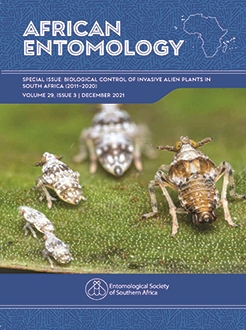Cactaceae are among the most problematic invasive alien plants in South Africa, posing serious negative consequences to agriculture and natural ecosystems. Fortunately, South Africa has a long and successful history of controlling cactus weeds using biological control (biocontrol). This paper reviews all the biocontrol programmes against invasive alien Cactaceae in South Africa, focusing on the decade since the last review published in 2011, up to, and including 2020. Biocontrol programmes against 16 target weeds are summarised, all of which rely on either the galling mealybug, Hypogeococcus sp. (Pseudococcidae), or various species or intraspecific lineages of cochineal insects (Dactylopius spp., Dactylopiidae) as agents. New agents are being considered for the three target weed species, Opuntia elata Salm-Dyck, Opuntia megapotamica Arechav. and Trichocereus spachianus (Lem.) Riccob., while permission to release a new agent against Cylindropuntia pallida (Rose) F.M. Knuth has recently been granted. The biocontrol agent, Dactylopius opuntiae (Cockrell) ‘stricta’, which has been utilised for the successful control of Opuntia stricta Haw., has shown some promise as an agent against one of the worst cactus weeds in the country, the North Cape/Free State variety of Opuntia engelmannii Salm-Dyck. Post-release monitoring and recent observations of the status of control for the 11 other cactus weeds, all of which have well-established agents, are provided. Taxonomic uncertainties and misidentifications of both target weeds and agents has been a constraint to biocontrol efforts, but this has been partially overcome through the use of genetic techniques. Biocontrol is particularly successful in controlling cactus weeds compared to most other taxonomic groups, and it is likely that past successes can be repeated with new target weeds. Mass-rearing and redistribution of agents are essential to gain the maximum possible benefit from cactus biocontrol agents, and recent increases in mass-rearing outputs have been beneficial.
How to translate text using browser tools
31 December 2021
Biological Control of Cactaceae in South Africa
I.D. Paterson,
H. Klein,
P.C. Muskett,
T.C. Griffith,
S. Mayonde,
K. Mofokeng,
Z. Mnqeta,
N. Venter
ACCESS THE FULL ARTICLE
It is not available for individual sale.
This article is only available to subscribers.
It is not available for individual sale.
It is not available for individual sale.

African Entomology
Vol. 29 • No. 3
December 2021
Vol. 29 • No. 3
December 2021
Biocontrol success
cochineal
Hypogeococcus
mass-rearing
post-release evaluation





